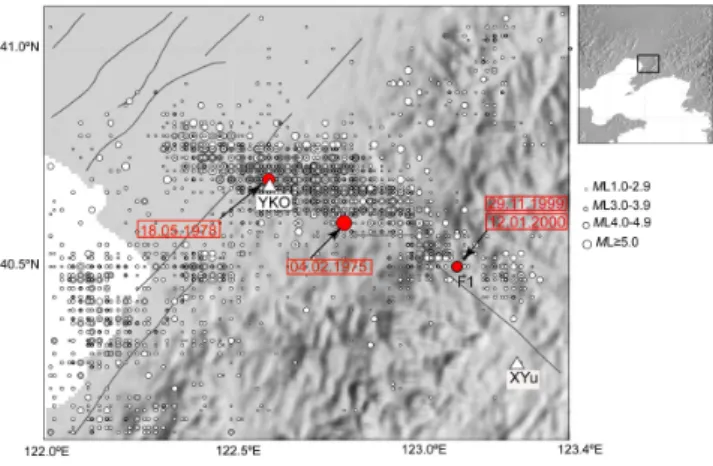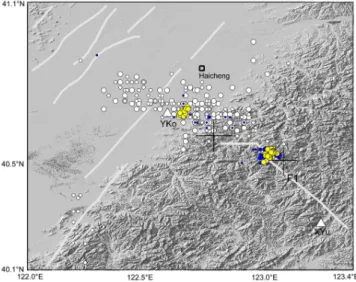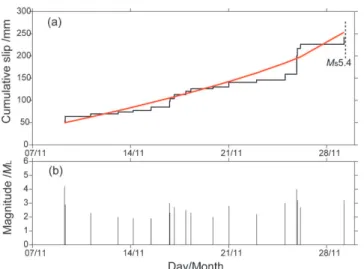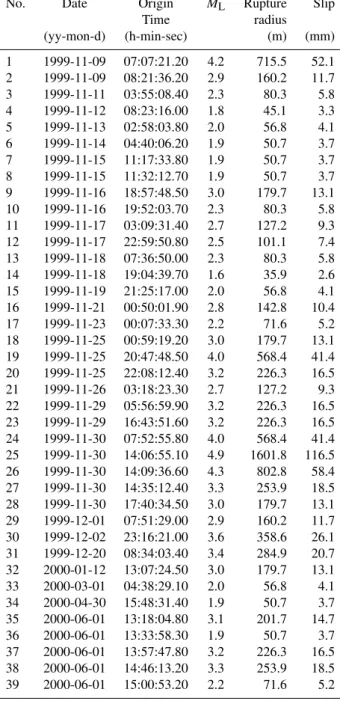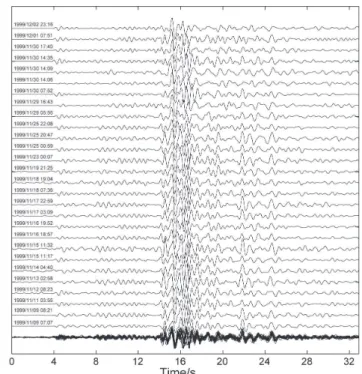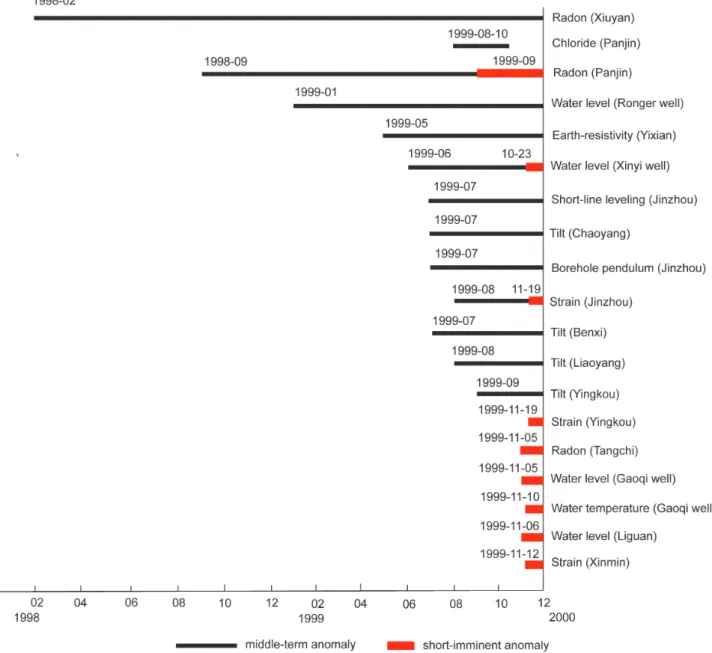www.nat-hazards-earth-syst-sci.net/11/1969/2011/ doi:10.5194/nhess-11-1969-2011
© Author(s) 2011. CC Attribution 3.0 License.
and Earth
System Sciences
Time-lapse slip variation associated with a medium-size earthquake
revealed by “repeating” micro-earthquakes: the 1999 Xiuyan,
Liaoning,
M
S
= 5.4 earthquake
Y. T. Li1,2, Z. L. Wu1, H. P. Peng1, C. S. Jiang1, and G. P. Li2
1Institute of Geophysics, China Earthquake Administration, Beijing 100081, China 2Earthquake Administration of Liaoning Province, Shenyang 110034, China
Received: 14 November 2010 – Revised: 22 February 2011 – Accepted: 15 June 2011 – Published: 14 July 2011
Abstract.We obtained the time-lapse cumulative slip before and after the 29 November 1999, Xiuyan, Liaoning, China,
Ms= 5.4 earthquake by using “repeating events” defined by waveform cross-correlation. We used the seismic waveform data from the Liaoning Regional Seismograph Network from June 1999 to December 2006. Two “multiplets” located near the seismogenic fault of the 1999 Xiuyan earthquake and the 4 February 1975, HaichengMs= 7.3 earthquake, respec-tively, were investigated. For the “multiplet” that occurred before and after the 1999 Xiuyan earthquake, apparent pre-shock accelerating-like slip behavior, clear immediate-post-seismic change, and relaxation-like post-immediate-post-seismic change can be observed. As a comparison, for the “multiplet” near the 1975 Haicheng earthquake which occurred a quarter century ago, the cumulative slip appears linear with a much smaller slip rate.
1 Introduction
Critical-point-like behavior of the preparation process of a single earthquake is a complicated problem with controver-sial opinions and discussed by many scientists (e.g., Varot-sos and Alexopoulos, 1984a, b; Jaum´e and Sykes, 1999; Kapiris et al., 2003). The solution has to be multidimen-sional resulting from the combination of different kinds of precursors with different spatio-temporal scales. For the
Correspondence to:Z. L. Wu (wuzl@cea-igp.ac.cn)
Fig. 1. Earthquakes with ML≥1.0 recorded by the Liaoning
Province Seismograph Network since 1970. Red dots show the 4 earthquakes withMs≥5.0 within this time period, including the 1975 HaichengMs= 7.3 earthquake, the 1978 YingkouMs= 5.9
earthquake, the 1999 XiuyanMs= 5.4 earthquake, and the 2000 XiuyanMs= 5.1 earthquake. Grid-like distribution of epicenters
reflects the limitation of the location capability. For earthquakes larger thanMs=7.0, the epicenter reflects the initiation point of the earthquake rupture. The 1975 Haicheng earthquake ruptured 54 km striking N70◦W, with dip angle 81◦dipping NE. Tectonic faults are shown by dark gray lines, in which the NW striking fault (F1) is the Haicheng River-Dayang River fault causing the 4 earth-quakes aboveMs5.0. Location of the Xiuyan (XYu) station and
the Yingkou (YKo) station are also shown in the figure by white triangles.
micro-earthquakes in the region of the 29 November 1999, Xiuyan, Liaoning, China,Ms= 5.4 earthquake. This earth-quake was one of the important earthearth-quake cases in China, with experimental prediction and detailed follow-up stud-ies (Jiao et al., 2002; Schaff and Richards, 2004b; Schaff, 2010). We explore whether some clues (even if with clearly limited significance caused by the limitation of retrospective case studies) could be obtained by examining the time-lapse slip variation revealed by “repeaters” before and the after this earthquake. This investigation has close relation to, but is in-trinsically different from, conventional foreshock studies due to the characteristics of “repeating events”.
2 Region under study
The Xiuyan earthquake occurred at 12:10:39 local time (04:10:39 UTC) on 29 November 1999, with the mainshock epicenter located at 40◦
31.5′
N×123◦ 04.5′
E according to the report of the Liaoning Province Earthquake Administra-tion. Depth was reported as 10 km, an apparent “convention estimate” due to the limitation on the accuracy and preci-sion of location results mainly caused by the crustal struc-ture model. Routine determination of the Liaoning Province Seismograph Network uses the magnitude transfer relation
Ms=1.13ML−1.27, which gives the surface wave magni-tude and the local magnimagni-tudeMs= 5.4 andML= 5.9, respec-tively, for this earthquake in which the directly determined magnitude was ML using short-period seismic recordings. Field survey, intensity distribution, and aftershock distribu-tion showed that the N64◦
W nodal of the focal mechanism solution represents the earthquake rupture, dipping NE with dip angle 84◦
. The earthquake was associated with the left-lateral strike-slip of the northwest-trending Haicheng River-Dayang River fault that also caused the 1975 Haicheng earth-quake. At a larger spatial scale, the cause of the active move-ment of this fault as well as its neighboring faults is still a puzzle in geodynamics, since this region belongs to the mar-gin of the north China craton. The geodynamics for the north China craton to be re-activated is just under study. Figure 1 shows the earthquakes in this region since 1970, together with topography and the distribution of active faults.
3 Data analysis
We used the data from the Liaoning Province Seismograph Network, the former Shenyang Telemetered Seismograph Network, composed of a data center and a central station lo-cated in Shenyang (the capital city of Liaoning Province), 15 digital telemetered seismic stations, and 4 data transmis-sion nodes within the territory of Liaoning Province. The network has been upgraded to digital since June 1999. In-struments mainly include broadband (BB) and/or short pe-riod (SP) seismographs, with sampling frequency 50 Hz. Figure 2 is the distribution of these stations and their fre-quency response, together with the earthquakes under study, recorded by this seismological observation system.
To study the whole sequence of earthquakes one needs to ensure the completeness of the earthquake catalogue. For doing this, considering the methodology for identifying “re-peating earthquakes” (as described in detail in the follow-ing sections), we applied a “multi-scale zoomfollow-ing-in” strat-egy. That is, we use the seismic stations located in a larger area (the whole Fig. 2) rather than just the “focused” region under consideration (the box with solid line in Fig. 2, or the region shown in Figs. 1 and 4). Next, to avoid the loss of “repeating events” near the border of the study region (the box in solid line in Fig. 2), we considered a somewhat larger region (the box with dashed line) encompassing it.
We selected the waveform data of the events with clear P phase pickings at no less than 3 stations for the pe-riod June 1999 to December 2006 within the spatial range 39.9∼41.3◦
N, 121.8∼123.6◦
E (the dashed box in Fig. 2). There are a total 1358 events (with maximum magnitude
Fig. 2. (Top) Distribution of earthquakes and seismic stations used for this study. Earthquakes are shown by gray dots. Shown in red are the “repeating earthquakes” identified by waveform cross-correlation. Yellow dots show the two “multiplets” under consideration. Gray lines indicate tectonic faults. Box in the indexing figure indicates the whole region under consideration. In the region, box with solid lines highlights the study region (40.1∼41.1◦N, 122∼123.4◦E) as shown in Figs. 1 and 4, encompassed by a larger box with dashed lines (39.9∼41.3◦N, 121.8
∼123.6◦E) to ensure the completeness of the “repeater” catalogue. Seismic stations are shown by triangles, with letters nearby indicating the name of the station. (Bottom) Instrumental response of the seismographs (from the Data Center of Liaoning Digital Seismograph Network).
magnitude isML. Accordingly, in the text and the figures it is noted byMLor simplyM. To check the completeness of the event sequence, Fig. 3 shows the frequency-magnitude dis-tribution of these 1358 earthquakes, which indicates that the completeness magnitude can be safely selected asML= 1.9.
Before the cross-correlation of waveforms, pre-processing was taken using a 0.5∼5 Hz bandpass filter to BB record-ings and a 1∼5 Hz bandpass filter to SP recordings. Jiang et al. (2008) discussed in detail the effect on the selection of “repeaters” by the mixture of BB and SP waveforms. The whole waveform composed of P, S, and coda phases was se-lected. Waveform was picked 4 s before the Pg arrival, and the whole waveform length was taken as 4 times of the S-P travel time difference. For the present station-epicenter
distances, according to the empirical local knowledge of seismic observation, the S-P travel time difference can be roughly estimated by the apparent velocity 8 km s−1. Slid-ing window was taken as 4 s less than the length of the whole waveform, sliding from the beginning point (4 s before the Pg arrival), with step of 1 sample. For regional seismic record-ings, such processed waveform covers the whole wave train from P arrival to coda reverberations, while avoiding the dis-turbance from noise.
Fig. 3. Frequency-magnitude distribution of the events in the dashed box (39.9∼41.3◦N, 121.8
∼123.6◦E) in Fig. 2, consist-ing of 1358 events, showconsist-ing the completeness of the sequence se-lected. Light grey squares show the cumulative magnitude distri-bution, while white diamonds show the magnitude distribution it-self (the differential distribution). Red solid line fits the Gutenberg-Richter’s law. Completeness magnitude can be selected by visual inspection asML= 1.7 according to the end of the power-law-like
frequency-magnitude distribution, seen both from the cumulative and the differential distribution curves. In the study, completeness magnitude is selected more conservatively asML= 1.9.
events”, with three or more stations having the (maximum sliding) cross-correlation coefficients larger than 0.8. Among these 307 “repeaters” which form “pairs” and/or “multiplets” with other events, there are 295 located within the solid box, the region under study. Such a “multi-scale zooming-in” strategy avoids the problems caused by the lack of available stations and the missing of “repeaters” near the boundary of the study region. From Figs. 2 and 4 it can be seen that there are only two stations (XYu and YKo) located in the study re-gion, which means that if the distribution of stations and the distribution of earthquakes take the same area, then it is not possible to identify the “repeaters” according to the above-mentioned criteria.
4 Pre-, immediate-post-, and post-seismic slip indicated by a “multiplet”
There are quite a few different definitions of a “multiplet”. The senso lato “multiplet” refers to the case that one event in a “multiplet” has at least one partner, while the senso stricto “multiplet” refers to the case that any event has partnership with every other one within the same “multiplet”. A “multi-plet” withnevents is also called “n-plet”. In this study we take the senso lato definition of a “multiplet”. Tables A1 and A2, as well as Figs. A1 and A2, show two examples. One
Fig. 4.Aftershocks of the 1975 Haicheng earthquake (ML≥3.0, to-taling 222 events, shown by white dots) and the 1999 Xiuyan earth-quake (ML≥2.0, totaling 82 events, shown by blue dots) as back-ground of the “multiplets”. Two groups of “multiplets” in the south-ern Liaoning region (shown by the solid box in Fig. 2) are shown by yellow dots. Stations in the surrounding of these “multiplets”, YKo and XYu, are shown by white triangles. White thick line, in-dicated by F1, shows the Haicheng River-Dayang River fault. The two crosses in black represent the epicenters of the 1975 Haicheng earthquake and the 1999 Xiuyan earthquake, respectively.
of them is a 57-plet that occurred from 1999 to 2004 near Xiuyan, the other one is a 19-plet near Yingkou. The loca-tions of these two “multiplets” are shown in Fig. 4. These two “multiplets” locate near the source region (as indicated, indirectly but effectively, by the aftershock sequences shown on the map) of the 1975 HaichengMs= 7.3 earthquake (to the west) and the 1999 XiuyanMs= 5.4 earthquake (to the east), respectively. For the Xiuyan “multiplet” (shown in Ta-ble A1), there are 22 events before the occurrence of the 1999 Xiuyan earthquake and 35 aftershocks that followed. Taking the complete catalogue aboveML=1.9, these two “multi-plets” become a “52-plet” and a “15-plet”, respectively.
Fig. 5. (a)Cumulative slip plot for all the events of the Xiuyan 52-plet, with the vertical dashed line indicating the origin time of the 1999 XiuyanMs= 5.4 earthquake (which is not belonging to this 52-plet and accordingly not shown in the cumulative slip plot). (b)Zooming-in of Fig. 5a, with the vertical dashed line indicating the origin time of the 1999 Xiuyan earthquake.
“multiplets” deal with a special spatial range near an earth-quake fault, while foreshocks may distribute in a wider area. Similar to previous approaches (e.g., Li et al., 2007, 2009), estimation of slip is conducted in the following steps. Firstly, calculate seismic moment by magnitude of earthquakes via logM0=16.1+1.5ML(Hanks and Kanamori, 1979). Next, radius r of the assumed circular rupture is estimated by
r= 7M0161σ1/3 (Kanamori and Anderson, 1975), in which stress drop is taken as1σ=3 MPa. Lastly, slipd is deduced byd=M0/µπ r2in which the rigidity of the source medium is taken asµ=3×1010N m−2. Obviously this cal-culation includes several assumptions and is not the direct estimate of slip amount. In principle, the calculation here is similar to the calculation of Benioff strain in that the source parameter, either slip in this case or Benioff strain, is not measured directly but calculated from magnitude.
Figure 5a shows the cumulative slip for all the events of the Xiuyan “multiplet”, with the vertical dashed line indicating the origin time of the 1999 XiuyanMs= 5.4 earthquake. The Xiuyan main shock does not belong to this “multiplet”, and thus not shown in the cumulative slip plot. But the increase of aftershocks caused by the main shock can be clearly seen in Fig. 5b, a zooming-in of Fig. 5a, which shows a clear im-mediate post-seismic change. Also from Fig. 5a and b, the Omori-law-like post-seismic relaxation process is clear.
5 Pre-shock accelerating slip?
Figure 6a is a further zooming-in of Fig. 5a and b. The red line indicates the fitting of the cumulative slip curve priori to the Xiuyan earthquake by6d=A+B (t0−t )m, in which
6dis the cumulative slip,t0is the time of the Xiuyan earth-quake (as shown by the vertical dashed lines),AandB are constants, andmis the coefficient indicating the overall prop-erty of the curve. Taking the experiences of the AMR inves-tigation (e.g., Brehm and Braile, 1998; Bowman and King, 2001), if m is less than 1, then the curve is accelerating-like; ifmis larger than 1, then the curve is relaxation-like; if mis near unity, then the curve is linear. In this fitting, the number of data points is 22, andm=0.57, indicating an accelerating-like trend. Note that AMR for a long time scale and foreshock-like sequence for a short time scale has self-similar properties in the critical-point-like process approach-ing the earthquake. Tools for the identification of accelerat-ing trend can be used for both cases, although the physics lying behind may differ.
A linear fitting has two free parameters to determine, while a power-law fitting has three or four, depending on whether the “failure time”t0is to be calculated. To avoid the problem of over-fitting, an additional consideration is the BIC gain that balances the residual of the fitting and the degrees-of-freedom of the model (Jiang and Wu, 2009). By definition, a reasonable fitting has to satisfy the criteria1BIC≥0. In the case of Fig. 6,1BIC = 3.3, indicating that acceleration is a better description than a simple linear increase.
As shown by Fig. 6b, the magnitude-time plot for these “repeaters” before the Xiuyan earthquake, the “accelerating-like process” as observed above, reflects only an overall trend over a pretty long time duration. In the perspective of earthquake forecast, the lack of data samples makes it hard to establish a baseline of slip rate before the main shock, therefore the observation here does not mean that a practi-cal scheme for earthquake forecast could be obtained based on this acceleration-like property, albeit this is the best data we can get up to now.
Fig. 6. (a)Power-law fit of the pre-shock cumulative slip curve, for the “repeaters” within the Xiuyan 52-plet, occurred before the Xiuyan earthquake. The power-law curve is represented by the red line, showing the accelerating-like behavior. This figure is a fur-ther zooming-in of Fig. 5a and b. (b)Magnitude-time plot of the “repeating earthquake sequence” in(a). It is somehow similar to foreshock activities, but the spatial range is limited to the range of the “multiplet”.
the understanding of earthquake preparation. The relation between the pre-seismic accelerating-like slip observed here and other precursor-like anomalies reported (Fig. A3 and Ta-ble A3) needs further investigation. Note that earthquakes with clear pre-seismic changes and/or anomalies are not common characteristics; we are therefore not sure whether the observation here for the Xiuyan “multiplet” is valid for other earthquake cases.
6 Conclusions and discussion
“Repeating earthquakes”, a concept having been proposed since decades ago based on waveform cross-correlation and accurate/precise location, has shown its potential in the as-sessment of earthquake recurrence and slip rates (Vidale et al., 1994; Nadeau et al., 1995; Igarashi et al., 2003) as well as the study of the physics of earthquake rupture (Anoosheh-poor and Brune, 2001; Beeler et al., 2001; Sammis and Rice, 2001). In this study, by analyzing two “multiplets” in Liaon-ing Province, we provide a case of pre-, immediate-post-, and post-seismic slip revealed by “repeating earthquakes” associ-ated with the 1999 Xiuyan earthquake. Somewhat interest-ing is the case of the acceleratinterest-ing-like cumulative-slip before thisMs= 5.4 earthquake. This accelerating-like process is near the earthquake fault or within the earthquake fault zone and its close surroundings. This approach has some similar-ities with the AMR studies in the perspective of the critical-point-like behavior in the earthquake preparation process, but deals with a short time scale. This approach shares some
Fig. 7. (a)Cumulative slip plot for the Yinkou 15-plet, with the aspect of coordinates maintaining the same slope as that in Fig. 6a for comparison of the slip rate.(b)The same as(a), with the vertical coordinate magnified by 10 times. Red line shows the fit of the cumulative slip curve.
similarities with foreshock studies, but is different in that it deals with a special spatial range – the span of a “multiplet”. The observation in this approach may have some relations with the precursors observed before the Xiuyan earthquake, but at the present time further investigation is needed, as the present approach provides at most a heuristic clue. Obvi-ously, case studies have limited significance in the statistical perspective, and retrospective case studies especially have limited significance in the forecasting perspective. However, accumulation of cases of earthquakes plays an important role at the present stage for testing the physical models of earth-quakes against real seismic data, and we are looking forward to more similar cases so that comparisons can be made.
Appendix A
Background information
Appendix A provides the seismic waveforms (Figs. A1 and A2) and parameters (Tables A1 and A2) of the “multiplets” under study, together with the background information of the prediction of the 1999 Xiuyan earthquake (Fig. A3 and Ta-ble A3).
Table A1.Parameters of the Xiuyan “multiplet”.
No. Date Origin ML Rupture Slip
Time radius
(yy-mon-d) (h-min-sec) (m) (mm)
1 1999-11-09 07:07:21.20 4.2 715.5 52.1 2 1999-11-09 08:21:36.20 2.9 160.2 11.7 3 1999-11-11 03:55:08.40 2.3 80.3 5.8 4 1999-11-12 08:23:16.00 1.8 45.1 3.3 5 1999-11-13 02:58:03.80 2.0 56.8 4.1 6 1999-11-14 04:40:06.20 1.9 50.7 3.7 7 1999-11-15 11:17:33.80 1.9 50.7 3.7 8 1999-11-15 11:32:12.70 1.9 50.7 3.7 9 1999-11-16 18:57:48.50 3.0 179.7 13.1 10 1999-11-16 19:52:03.70 2.3 80.3 5.8 11 1999-11-17 03:09:31.40 2.7 127.2 9.3 12 1999-11-17 22:59:50.80 2.5 101.1 7.4 13 1999-11-18 07:36:50.00 2.3 80.3 5.8 14 1999-11-18 19:04:39.70 1.6 35.9 2.6 15 1999-11-19 21:25:17.00 2.0 56.8 4.1 16 1999-11-21 00:50:01.90 2.8 142.8 10.4 17 1999-11-23 00:07:33.30 2.2 71.6 5.2 18 1999-11-25 00:59:19.20 3.0 179.7 13.1 19 1999-11-25 20:47:48.50 4.0 568.4 41.4 20 1999-11-25 22:08:12.40 3.2 226.3 16.5 21 1999-11-26 03:18:23.30 2.7 127.2 9.3 22 1999-11-29 05:56:59.90 3.2 226.3 16.5 23 1999-11-29 16:43:51.60 3.2 226.3 16.5 24 1999-11-30 07:52:55.80 4.0 568.4 41.4 25 1999-11-30 14:06:55.10 4.9 1601.8 116.5 26 1999-11-30 14:09:36.60 4.3 802.8 58.4 27 1999-11-30 14:35:12.40 3.3 253.9 18.5 28 1999-11-30 17:40:34.50 3.0 179.7 13.1 29 1999-12-01 07:51:29.00 2.9 160.2 11.7 30 1999-12-02 23:16:21.00 3.6 358.6 26.1 31 1999-12-20 08:34:03.40 3.4 284.9 20.7 32 2000-01-12 13:07:24.50 3.0 179.7 13.1 33 2000-03-01 04:38:29.10 2.0 56.8 4.1 34 2000-04-30 15:48:31.40 1.9 50.7 3.7 35 2000-06-01 13:18:04.80 3.1 201.7 14.7 36 2000-06-01 13:33:58.30 1.9 50.7 3.7 37 2000-06-01 13:57:47.80 3.2 226.3 16.5 38 2000-06-01 14:46:13.20 3.3 253.9 18.5 39 2000-06-01 15:00:53.20 2.2 71.6 5.2
40 2001-05-16 05:44:23.40 2.4 90.1 6.6 41 2002-03-23 05:38:05.40 2.1 63.8 4.6 42 2002-03-23 05:50:53.10 2.1 63.8 4.6 43 2002-07-02 07:00:47.20 2.4 90.1 6.6 44 2002-08-07 06:11:11.20 3.4 284.9 20.7 45 2002-08-11 14:04:24.50 2.0 56.8 4.1 46 2002-09-15 12:33:58.50 2.4 90.1 6.6 47 2002-10-15 13:11:02.40 1.9 50.7 3.7 48 2002-10-18 13:18:02.50 2.3 80.3 5.8 49 2002-11-07 01:16:32.40 1.6 35.9 2.6 50 2003-05-14 15:14:21.40 2.2 71.6 5.2 51 2003-12-30 09:02:15.60 1.6 35.9 2.6 52 2003-12-30 13:06:21.30 1.9 50.7 3.7 53 2003-12-30 13:39:38.80 1.7 40.2 2.9 54 2003-12-31 15:24:53.10 2.0 56.8 4.1 55 2003-12-31 15:52:04.20 2.9 160.2 11.7 56 2004-01-02 00:38:38.00 3.3 253.9 18.5 57 2004-01-04 06:58:24.00 2.3 80.3 5.8
Table A2.Parameters of the Yingkou “multiplet”.
No. Date Origin ML Rupture Slip
Time radius
(yy-mon-d) (h-min-sec) (m) (mm) (mm)
Table A3.References related to the prediction of the 1999 Xiuyan earthquake.
Chen, X. Z., Gai, Z. X., Zhou, S. Y., Guo, T. S., and Zhu, L. R.: The investigation of rupture process of the Xiuyan 5.4 earthquake on November 29, 1999, Acta Seismologica Sinica, 23(6), 659–662, 2001 (in Chinese with English abstract).
Cao, F. J., Guo, X. Y., Jia, X. D., Xin, Y. T., and Liu, Y. F.: Study on variability characteristics of the earthquake synthetical information variable S-value before Xiuyan 5.4 earthquake, Seismological Research of Northeast China,22(3), 24–32, 2006 (in Chinese with English abstract).
Diao, G. L., Zhou, S. Y., Liu, J., Zhang, X. M., Li, X. F., and Zhang,M.: Anomalies of meanVP/VSratio in the series of Xiuyan
earthquake, North China Earthquake Sciences, 23(4), 1–5, 2005 (in Chinese with English abstract).
Gu, G. Y., Yu, L. W., Wang, A. D., Lu, L. Y., and Wan, Y. Y.: The imminent prediction for Xiuyan earthquake with Ms5.4 in Liaoning Province, Earthquake, 21(1), 78–84, 2001(in Chinese with English abstract).
Guo, B. C., Zhou, H. Y., Ji, D. M., Sun, Y., and Shuang, F.: Relation between electromagnetic radiation anomalies and the Xiuyan earthquake, Seismological Research of Northeast China, 17(2), 23–27, 2001 (in Chinese with English abstract).
Jiang, X. Q. and Tong, X. H.: Synthetic Description about Xiuyan-Haicheng, Liaoning earthquake with magnitude of Ms5.4 on November 29, 1999, Seismological and Geomagnetic Observation and Research, 22(2), 2–9, 2001 (in Chinese with English abstract).
Lan, C. X., Liu, J., Ma, S. Z., Wu, M. J., and Miao, C. L.: Study on stress variation characteristics of Xiuyan 5.4 earthquake series, Earthquake, 26(2), 73–82, 2006 (in Chinese with English abstract).
Li, F. and Yu, L. W.: Seismologic anomaly features prior to Xiuyn-Haicheng Ms5.6 earthquake, Seismological Research of Northeast China, 16(2), 50–55, 2000 (in Chinese with English abstract).
Li, F. and Yu, X. F.: Amplitude ratio characteristics of prior and posterior to Xiuyan Ms5.4 earthquake, Seismological Research of Northeast China, 20(3), 33–38, 2004 (in Chinese with English abstract).
Li, J., Li, X. L., Liu, R. F., Fan, J., and Zhao, X. H.: Study on the characteristics and mechanism of deformation anomaly in Yantai region before Xiuyan earthquake with Ms5.4, Earthquake, 26(3), 71–78, 2006 (in Chinese with English abstract).
Li, Y. E. and Chen, X. Z.: Determination and scaling relationship analysis of source parameters of the Nov. 29, 1999 Xiuyan 5.4 earthquake sequence, Earthquake, 27(4), 59–67, 2007(in Chinese with English abstract).
Liu, G. H., Tong, F. L., Zhang, Z. L., Zeng, Q. H., and Li, J.: Anomalous characteristics of underground fluid in Liaohe basin prior to XiuyanMs5.6 earthquake, Seismological Research of Northeast China, 16(4), 44–51, 2000 (in Chinese with English
abstract).
Liu, Y. S., Liu, G. H., and Tong, F. L.: Anomalous characteristics of underground fluid in Liaohe basin before the 1999 Xiuyan Ms5.6 earthquake, Liaoning, Northwestern Seismological Journal, 22(3), 241–246, 2000 (in Chinese with English abstract).
Lu, P. L., Zheng, D. L., Liu, P. X., Chen, X. Z., Chen, R. H., Wang, H. M., and Lu, M. M.: The impending prediction and seismicities of the 1999 Xiuyan earthquake, Recent Developments in World Seismology, 3, 4–7, 2000 (in Chinese with English abstract).
Lu, P. L., Yang,Z. X., Wang, X. Q., Ding, X., and Dou, A. X.: Investigation of the 1999 Xiuyan earthquake sequence, Liaoning Province, China, Earthquake, 24(4), 45–50, 2004 (in Chinese with English abstract).
Luo, Z. L., Wang, W. J., and Chen, L.: The time-frame coefficient method to diagnose nonlinear characteristics of earthquake sequences in Haicheng-Xiuyan region, Liaoning province, Earthquake, 20(Supplement), 18–27, 2000 (in Chinese with English abstract).
Qiu, X. L., Qiu, X. H., Wang, B., Liu, R. F., and Li, J.: Water radon anomaly before and after Xiuyan-Haicheng Ms5.6 earthquake, Seismological Research of Northeast China, 24(4), 70–75, 2008 (in Chinese with English abstract).
Sun, W. F., Wang, Y. Y., and Li, F.: Study on characteristics of earthquake swarm sequence prior to Xiuyan-Haicheng Ms5.6 earthquake,1999, Seismological Research of Northeast China, 16(2), 45–49, 2000 (in Chinese with English abstract).
Sun, W. F. and Jiao, M. R.: Tracing study on earthquake sequence to the Xiuyan-Haicheng Ms5.6 earthquake, 1999, Seismo-logical Research of Northeast China, 17(2), 8–16, 2001 (in Chinese with English abstract).
Sun, W. F., Cao, F. J., Li, F., and Yu L., W.: Study on seismicity evolution and short-term and imminent anomaly indexes before and after Xiuyan Ms5.4 earthquake, Seismological Research of Northeast China, 19(2), 16–27, 2003 (in Chinese with English abstract).
Tai, L. X., Gao, Y., Cao, F. J., Shi, Y. T., Wu, J., and Jiao, M. R.: Shear-wave splitting before and after the 1999 Xiuyan earthquake in Liaoning, China, Acta Seismologica Sinica, 30(4), 340–354, 2008 (in Chinese with English abstract).
Wang, H. Y.: Hydrogeochemical anomalies prior to Xiuyan-Haicheng Ms5.6 earthquake, Seismological Research of Northeast China, 16(2), 56–60, 2000 (in Chinese with English abstract).
Wang, L. Y., Chen, P. Y. , Chen, X. Z., Wang, Q., and Li, F.: Study on the time-varying seismic kinematic parameters of Xiuyan earthquake sequence in Liaoning Province, Earthquake, 25(2), 1–8, 2005 (in Chinese with English abstract).
Wang, Q., Chen, X. Z., and Wang, L. Y.: Change of apparent stress of Xiuyan earthquake sequence and its prediction signifi-cance, Earthquake, 25(2), 91–97, 2005 (in Chinese with English abstract).
Wang, W. J. and Liu, J.: Temporal process of S-Coda Qc of Xiuyan earthquake sequence in 1999, Earthquake, 24(4), 37–44, 2004 (in Chinese with English abstract).
Wang, Y. Y., Chen, D. F., and Wang, L. H.: Analysis of the Ms5.6 Xiuyan earthquake and the characteristic of deformation precursor anomaly in Liaoning province, Seismological Research of Northeast China, 16(2), 61–65, 2000 (in Chinese with English abstract).
Wu, J., Tai, L. X., Gao, Y., Shi, Y. T., and Jiao, M. R.: Discussions on stress accumulation before the 1999 XiuyanMs5.9 Earthquake in Liaoning, China, Earthquake, 29(3), 37–44, 2009 (in Chinese with English abstract).
Xu, X. T.: Some comments on the successful prediction of Xiuyan-Haicheng earthquake, Seismological Research of Northeast China, 16(2), 79–81, 2000 (in Chinese).
Yu, L. W.: Ponder deeply over the successful impending Xiuyan-Haicheng earthquake prediction, Seismological Research of Northeast China, 16(3), 16–20, 2000a (in Chinese with English abstract).
Yu, L. W.: Comprehensive analysis on tidal effect of seismicity in Liaoning Province, Earthquake, 20(Supplement), 176–182, 2000b (in Chinese with English abstract).
Yu, L. W., Li, F., Lu, L. Y., Chi, G. C., and Wang, H. Y.: Scientific summation of the successful prediction of Xiuyan-Haicheng
Ms5.6 earthquake on Nov. 29th, 1999, Seismological Research of Northeast China, 16(2), 14–26, 2000 (in Chinese with English abstract).
Zhang, L., Li, X. H., Liu, Z., and Dai, J.: The characteristic of electromagnetic precursor variation prior to Xiuyan-Haicheng
Ms5.6 earthquake, Seismological Research of Northeast China, 16(2), 66–70, 2000 (in Chinese with English abstract).
Zhang, P., Gu, G. Y., and Gao, Y. L.: Focal mechanism of Xiuyan-Haicheng (Ms5.4) earthquake sequence, Earthquake, 21(1), 98–102, 2001 (in Chinese with English abstract).
Zhang, P., Zou, X. R., and Qiu, X. L.: Abnormal characteristics of source parameter and seismic wave before XiuyanMs5.4 earthquake, Seismological and Geomagnetic Observation and Research, 29(2), 7–13, 2008 (in Chinese with English abstract).
Fig. A1.Filtered seismograms of the Xiuyan “multiplet” recorded at the Yingkou (YKo) station. The figure shows part of the seismograms recorded by the Yingkou station (YKo, BB seismograph), in which “part of” means that for the 57-plet, only the seismograms of the first 31 events before and immediately after the Xiuyan earthquake are shown. In the figure, each trace has been normalized and pre-processed by a 0.5∼5 Hz band pass filter. Bottom trace is the stacking of all the above traces. The clearness of the stacked trace indicates the similarity of the waveforms. Note that the “repeaters” are identified by the criteria that filtered waveforms of at least 3 stations (not necessarily including the YKo station) have the cross-correlation coefficients no less than 0.8. For some of the events, there are no waveform recordings at the YKo station.
Acknowledgements. Thanks are extended to the editors of the present special issue for their invitation to join in, and to the two re-viewers for constructive suggestions. Waveform data are provided by the Liaoning Province Seismograph Network. We thank Paul G. Richards for stimulating discussion on “repeating earthquakes”. This work is supported by the “Spark Project of Earthquake Sciences” (XH1006) of China Earthquake Administration.
Edited by: K. Eftaxias
Reviewed by: E. Dologlou and another anonymous referee
References
Anooshehpoor, A. and Brune, J. N.: Quasi-static slip-rate shield-ing by locked and creepshield-ing zones as an explanation for repeatshield-ing earthquakes at Parkfield, Bull. Seism. Soc. Amer., 91, 401–403, 2001.
Beeler, N. M., Lockner, D. L., and Hickman, S. H.: A simple stick-slip and creep-stick-slip model for repeating earthquakes and its im-plication for microearthquakes at Parkfield, Bull. Seism. Soc. Amer., 91, 1797–1804, 2001.
Bowman, D. D. and King, G. C. P.: Accelerating seismicity and stress accumlation before large earthquakes, Geophys. Res. Lett., 28, 4039–4042, 2001.
Brehm, D. J. and Braile, L. W.: Intermediate-term earthquake pre-diction using precursory events in the New Madrid seismic zone, Bull. Seism. Soc. Amer., 88, 564–580, 1998.
Cheng, X., Niu, F., Silver, P. G., Horiuchi, S., Takai, K., Iio, Y., and Ito, H.: Similar microearthquakes observed in western Nagano, Japan, and implications for rupture mechanics, J. Geophys. Res., 112, B04306, doi:10.1029/2006JB004416, 2007.
Hanks, T. C. and Kanamori, H.: A moment magnitude scale, J. Geophys. Res., 84, 2348–2350, 1979.
Hardebeck, J. L., Felzer, K. R., and Michael, A. J.: Improved tests reveal that the accelerating moment release hypothesis is statistically insignificant, J. Geophys. Res., 113, B08310, doi:10.1029/2007JB005410, 2008.
Igarashi, T. Matsuzawa, T., and Hasegawa, A.: Repeating earthquakes and interplate aseismic slip in the northeast-ern Japan subduction zone, J. Geophys. Res., 108, 2249, doi:10.1029/2002JB001920, 2003.
Jaum´e, S. C. and Sykes, L. R.: Evolving towards a critical point: a review of accelerating seismic moment/energy release prior to large and great earthquake, Pure Appl. Geophys., 155, 279–306, 1999.
Jiang, C.-S. and Wu, Z.-L.: Seismic moment release before the May 12, 2008, Wenchuan earthquake in Sichuan of southwest China, Concurrency Computat.: Pract. Exper., 22, 1784–1795, doi:10.1002/cpe.1522, 2009.
Jiang, C.-S., Wu, Z.-L., and Li, Y.-T.: Estimating the location accu-racy of the Beijing Capital Digital Seismograph Network using repeating events, Chinese Journal of Geophysics., 51, 817–827, 2008 (in Chinese with English abstract).
Jiao, W., Gu, H., and Gu, G.: Review of the earthquake prediction for the 29 November 1999M5.9 Xiuyan earthquake by relocat-ing the sequence with the double-difference method, Seism. Res. Lett., 73, p. 259, 2002.
Kanamori, H. and Anderson, D. L.: Theoretical basis for some em-pirical relations in seismology, Bull. Seismol. Soc. Amer., 65,
1073–1095, 1975.
Kapiris, P. G., Eftaxias, K. A., Nomikos, K. D., Polygiannakis, J., Dologlou, E., Balasis, G. T., Bogris, N. G., Peratzakis, A. S., and Hadjicontis, V. E.: Evolving towards a critical point: A possible electromagnetic way in which the critical regime is reached as the rupture approaches, Nonlin. Processes Geophys., 10, 511– 524, doi:10.5194/npg-10-511-2003, 2003.
King, G. C. P. and Bowman, D. D.: The evolution of regional seis-micity between large earthquake, J. Geophys. Res., 108, 2096, doi:10.1029/2001JB000783, 2003.
Kimura, H., Kasahara, K., Igarashi, T., and Hirata, N.: Repeat-ing earthquake activities associated with the Philippine Sea plate subduction in the Kanto district, central Japan: A new plate con-figuration revealed by interplate aseismic slips, Tectonophysics, 417, 101–118, 2006.
Li, L., Chen, Q. F., Cheng, X., and Niu, F. L.: Spatial cluster-ing and repeatcluster-ing of seismic events observed along the 1976 Tangshan fault, north China, Geophys. Res. Lett., 34, L23309, doi:10.1029/2007GL031594, 2007.
Li, L., Chen, Q. F., Niu, F. L., Fu, H., Liu, R. F., and Hou, Y. Y.: Slip rate along the Lijiang-Ninglang fault zone estimated from repeat-ing microearthquakes, Chinese Sci. Bull., 54, 447–455, 2009. Mignan, A. and Giovambattista, R. D.: Relationship
be-tween accelerating seismicity and quiescence, two precur-sors to large earthquakes, Geophys. Res. Lett., 35, L15306, doi:10.1029/2008GL035024, 2008.
Nadeau, R. M. and Johnson, L. R.: Seismological studies at Park-field VI: Moment release rates and estimates of source parame-ters for small repeating earthquakes, Bull. Seismol. Soc. Amer., 88, 790–814, 1998.
Nadeau, R. M. and McEvilly, T. V.: Fault slip rates at depth from re-currence intervals of repeating microearthquakes, Science, 285, 718–721, doi:10.1126/science.285.5428.718, 1999.
Nadeau, R. M., Foxall, W., and McEvilly, T. V.: Clustering and pe-riodic recurrence of microearthquakes on the San Andreas fault at Parkfield, California, Science, 267, 503–507, 10.1126/sci-ence.267.5197.503, 1995.
Papadopoulos, G. A., Charalampakis, M., Fokaefs, A., and Mi-nadakis, G.: Strong foreshock signal preceding the L’Aquila (Italy) earthquake (Mw6.3) of 6 April 2009, Nat. Hazards Earth Syst. Sci., 10, 19–24, doi:10.5194/nhess-10-19-2010, 2010. Rau, R. J., Chen, K. H., and Ching, K. E.: Repeating
earth-quakes and seismic potential along the northern Longitudinal Valley fault of eastern Taiwan. Geophys. Res. Lett., 34, L24301, doi:10.1029/2007GL031622, 2007.
Reasenberg, P. A.: Foreshock occurrence before large earthquakes, J. Geophys. Res., 104, 4755–4768, 1999.
Robinson, R.: A test of the precursory accelerating moment release model on some recent New Zealand earthquakes, Geophys. J. Int., 140, 568–576, 2000.
Robinson, R., Zhou, S. Y., Johnston, S., and Vere-Jones, D.: Precur-sory accelerating seismic moment release (AMR) in a synthetic seismicity catalog: A preliminary study, Geophys. Res. Lett., 32, L07309, doi:10.1029/2005GL022576, 2005.
Sammis, C. G. and Rice, J. R.: Repeating earthquakes as low-stress-drop events at a border between locked and creeping fault patches, Bull. Seism. Soc. Amer., 91, 532–537, 2001.
China, sequence and synthetic sensitivity tests, Geophys. J. Int., 180, 829–846, 2010.
Schaff, D. P. and Richards, P. G.: Repeating seismic events in China, Science, 303, 1176–1178, 2004a.
Schaff, D. P. and Richards, P. G.: Lg-wave cross correlation and double-difference location: application to the 1999 Xi-uyan, China, sequence, Bull. Seismol. Soc. Amer., 94, 867–879, 2004b.
Schaff, D. P., Beroza, G. C., and Shaw, B. E.: Postseismic response of repeating aftershocks, Geophys. Res. Lett., 25, 4549–4552, 1998.
Van Stiphout, T., Wiemer, S., and Marzocchi, W.: Are short-term evacuations warranted? Case of the 2009 L’Aquila earthquake. Geophys. Res. Lett., 37, L06306, doi:10.1029/2009GL042352, 2010.
Varnes, D. J.: Predicting earthquakes by analyzing accelerating pre-cursory seismic activity, Pure Appl. Geophys., 130, 661–686, 1989.
Varotsos, P. and Alexopoulos, K.: Physical properties of the vari-ations of the electric field of the earth preceding earthquakes, I, Tectonophysics, 110, 73–98, 1984a.
Varotsos, P. and Alexopoulos, K.: Physical properties of the varia-tions of the electric field of the earth preceding earthquakes, II. Determination of epicentre and magnitude, Tectonophysics, 110, 99-125, 1984b.
Vere-Jones, D., Robinson, R., and Yang, W. Z.: Remarks on the ac-celerated moment release model: problems of model formulation and estimation, Geophys. J. Int., 144, 517–531, 2001.
Vidale, J. E., Ellsworth, W. L., Cole, A., and Marone, C.: Variations in rupture process with recurrence interval in a repeated small earthquake, Nature, 36, 8624–8626, 1994.
Wang, K., Chen, Q.-F., Sun, S., and Wang, A.: Predicting the 1975 Haicheng earthquake. Bull. Seismol. Soc. Amer., 96, 757–795, 2006.
Wu, K.-T., Yue, M.-S., Wu, H.-Y., Chao, S.-L., Chen, H.-T., Huang, W.-Q., Tien, K.-Y., and Lu, S.-D.: Certain characteristics of the Haicheng earthquake (M=7.3) sequence, Chinese Geophysics, 1, Earthquake Research in China 2, AGU, 289–308, 1978. Wyss, M.: Evaluation of Proposed Earthquake Precursors,
